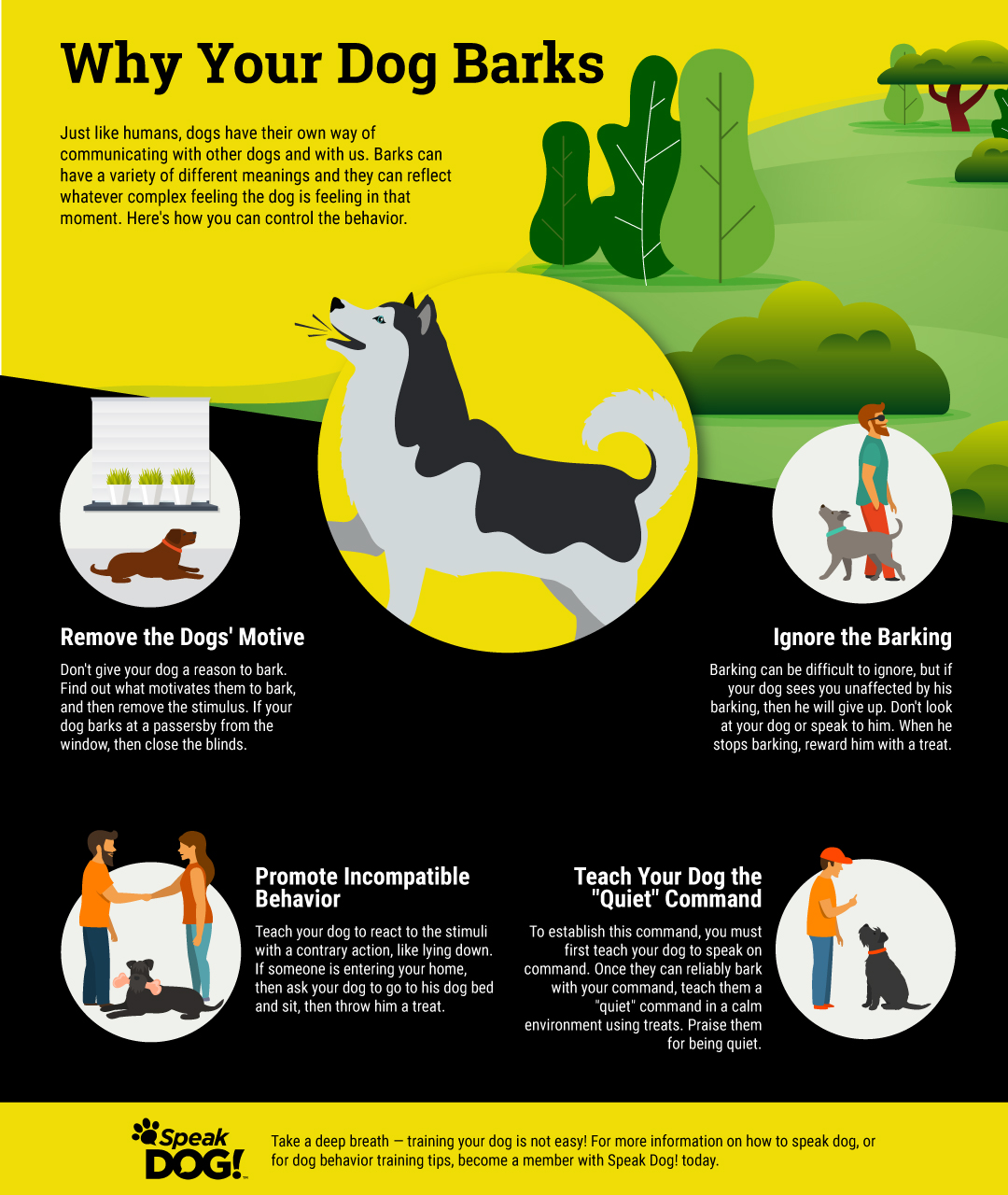Ask Steve: Barking
Barking: Why Does Your Dog Bark and What Does it Mean?
Humans have an intricate way of communicating with each other. Not only do we have written communication, but we have spoken communication, which is supremely powerful and effective. Dogs have their own system of communication too, of course, but it differs vastly from ours. Dogs communicate with us and other dogs through their barks, whines, body language, and growls. But most people are intrigued by their bark, as the significance behind each bark is elusive. Since we cannot understand our dogs’ common method of communication, we are left to wonder: What do these barks mean? Can these barks be trained? Can they be controlled? Read our blogs and subscribe to Speak Dog!™ for insider information from Steve Lankfer on how to speak to your dog and understand the language of your canine companion.

What Do Barks Mean?
Depending on the situation, barks can have a number of meanings. They mean more than just a “hey, someone’s at the door!!” or “play with me!” They are reactive, but further, they are complex and enable your dog to communicate their reaction to certain situations. If you own a dog, you’ve probably found that dogs bark when they’re excited, hungry, lonely, frightened, irritated, and more. Further, the dogs pitch, body language, and the number of barks in a row can vary with each kind of bark, which provides you with more context as to what they are communicating. Observe how your dogs react. Listen to how they bark when they meet a stranger, meet another dog, play with you, or alert you when someone is entering the house. Dogs alerting the house of an intruder will likely bark in a lower pitch where a dog enjoying playtime will bark in a higher pitch. Further, the row of barks can communicate the situation the dog is reacting to. A dog that barks once may be annoyed or surprised where a row of barks means that that dog is stimulated by a situation that is either disturbing or enticing. Next time, listen to your dog’s bark and try to categorize it. You’re probably better than you think!
How to Control Your Dog’s Bark
Getting your dog to stop barking is a matter of establishing yourself as its leader so that your dog knows you are in control and it doesn’t need to react unless you give it permission to do so. Changing your dog’s behavior is as simple as praising it for barks that you want to encourage, and correcting it for barks that you want to discourage. Training your dog to be obedient at all times is simply a matter of consistency. All you need is time, patience, and a dog that wants to talk (all dogs do). While you train your dog on the boundaries of barking, keep in mind not to yell. Dogs are drawn towards stability and withdraw from instability. Be positive, and be consistent. Dogs have an innate need for stable leadership which gives them a sense of safety. So it is necessary to establish yourself as someone they can trust while training them.
- Provide stability – If your dog reacts by barking at passerby through the window, use the opportunity to assure them you are in charge and are safe from needing their alarm. When you let your dogs go outside, provide stability in the same way so they aren’t left to decide for themselves when to bark at neighbors or strangers that they see.
- Ignore the bark – This technique can be rather tricky, but effective. Especially the singular bark that is directed at you. If your dog sees you unaffected by its bark, then they innately understand there is no reason for them to continue. While you’re ignoring your dog, fully turn around and don’t look at them, don’t touch them, and don’t talk to them. Do not acknowledge them. When your dog finally stops, reward them with a positive tone and give them your eye contact. Lengthen the amount of time they must be quiet for the best results.
- Promote alternative behavior – When your dog barks it is reacting to something. Whether it’s by seeing another dog walk by or from the doorbell ringing. Whatever the reason is, teach your dog to react to the stimuli by first looking to you before reacting. If someone is entering your home, then direct your dog to an area where they can sit and lay down. This will become their established routine achieved through repetition until the dog becomes indifferent and looks to you for permission.
Take a Deep Breath
Training your dog to unlearn annoying habits like barking can make you frustrated and possibly even hopeless. There are so many people who give up on training their dogs because they don‘t see results. Results take time, and good things come to those who work consistently to establish themselves as their dog’s leader! Remember that dogs can’t speak human. No matter what, love and lead your dog by speaking their language. Your furry canine companion knows nothing except for love and respect for you — you are your dog’s whole world! Read and watch Steve Lankfer guide you through the most common training difficulties. Stay positive and subscribe to Speak Dog!™ to learn how to speak to your dog today!

Join our canine community today!
Steve's Dog Place is the FREE place to talk about dogs, learn about their behavior, brag on your pet and more.
Make a pet profile
Share pics
Meet other dog lovers
Post canine questions
Earn Attaboy! Reward Points and more
